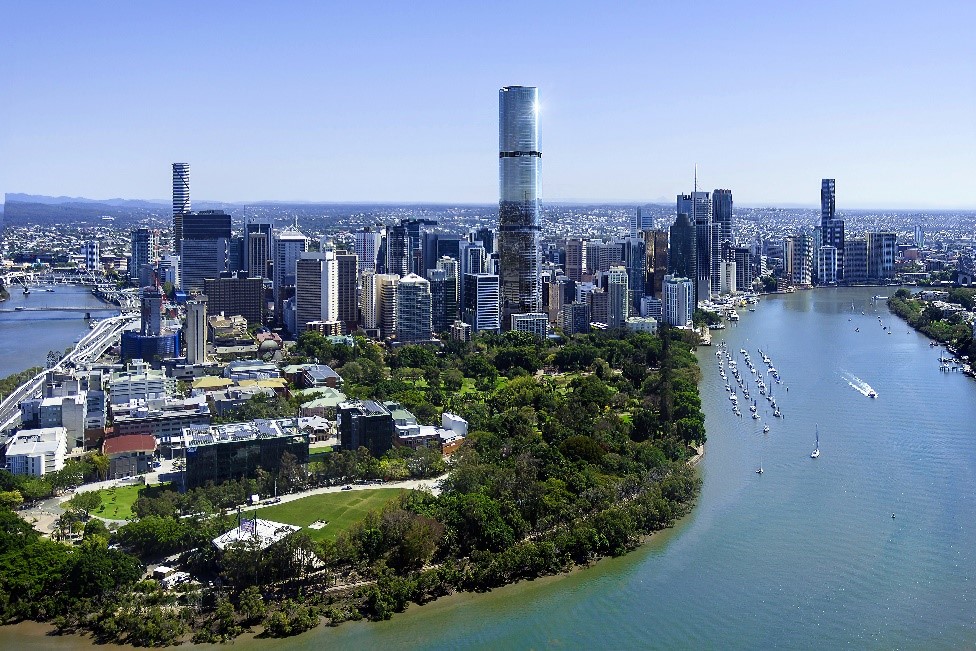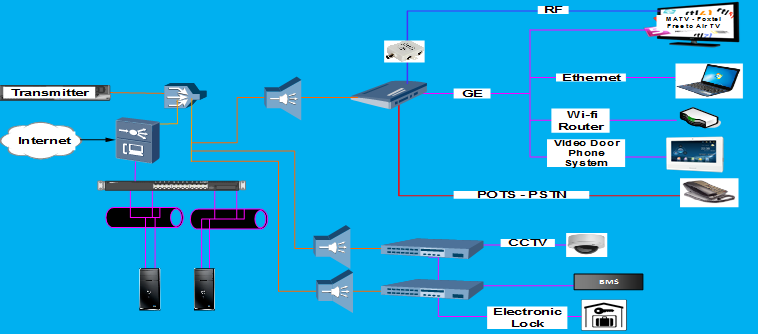Enjoying a Pleasant Day in Brisbane Skytower
Brisbane Skytower is a landmark building under construction in the city’s central business skyline. The skyscraper, in Brisbane, Queensland, Australia, is expected to be the best residential tower among all the tall buildings built recently. This iconic, 270-meter, 90-story residential tower will become Brisbane’s tallest building when completed. What will it be like to live in the Brisbane Skytower?

At dawn, when sunlight spills over the Brisbane River, various types of sensors installed in the Skytower will transmit data over an agile network to a building automation system. The building automation system will then trigger equipment to take action according to the preset rules. For example, lights will automatically dim in response to the sensed indoor illumination data; and the system will automatically reduce the air ventilation frequency that shows the indoor air quality has reached the best condition.
In the morning, you can go to the gym and start the day with healthy exercise. At noon, you may go downstairs with your family to have lunch, and then go shopping in the building. At dusk, infinity pools at the tower's crown will let you swim to the edge of the building, savoring long, spectacular vistas over the whole of Moreton Bay and Brisbane. You can share these memorable moments through a live streaming or social platform to people around the world. At the same time, the building management staff will guard you and the entire Skytower around the clock by using a state-of-the-art video surveillance system.
Brisbane Skytower will become a role model for smart buildings that Huawei and Honeywell — two Global 500 companies — have collaborated to make possible.
‘Network First’ for Smart Buildings
Today, the new generation of information technologies represented by the Internet of Things (IoT), cloud computing, and Big Data are growing quickly around the globe. This megatrend has a profound impact on the construction industry, with ‘sustainable, secure, and energy efficient’ becoming the three key characteristics of smart buildings.
The new Internet economy has also greatly changed people’s mindsets and behaviors. As buildings become popular places for people to eat and live, they are also rapidly evolving to become more networked, human-centric, and intelligent. The growing use of the IoT, cloud computing, and Big Data enables seamless interoperability between building intelligence systems and information systems. The IoT and social platform technologies are increasingly applied to daily property management and equipment room operations, taking building intelligence to a new level.
The network for buildings is also being transformed from providing simple telephone and television services to delivering all-round services such as video surveillance, Wi-Fi, and environmental awareness. The network is taking on a new look that features service diversity, intelligence, and mobility, which creates higher network requirements.
Wider bandwidths also are needed. Compared to the declining use of traditional PCs, a growing number of smart devices such as smartphones, 4K Internet TV, home surveillance appliances, and even home robots are being used in buildings. Additionally, buildings are making use of more building control, energy management, sensing, and surveillance equipment. All these additions call for a dramatic increase in network bandwidths.
Ubiquitous network access is also required in order to deliver anytime, anywhere access experience in rooms, elevators, lobbies, underground parking garages, and property management office areas. Property management owners also expect a simpler, faster-to-deploy, and easier-to-manage network that reduces labor costs while improving efficiency.
Bill McGarry, Development Manager of Billbergia Group, the management company, considered all these technology advancements when he approved Honeywell’s technology proposal. Bill also understood the importance of being able to “ready the building for the next wave of technology upgrades” and was more than confident Skytower technology was going to deliver the best outcome for its residents for years to come.
The Billbergia Group manages the entire property investment, development, construction, marketing and sales process, ensuring an integrated approach and delivery. The Huawei POL Solution complimented Billbergia’s structure as it delivers complete technology integration.
Huawei Provides POL Solution
In the Skytower project, Honeywell will provide the Enterprise Buildings Integrator, a building automation system, and take charge of system integration that includes Heating, Ventilation, and Air Conditioning (HVAC), security protection, and firefighting facilities. Additionally, Honeywell will centrally manage various building subsystems and provide a visualized management portal as well as alarm management and work order management services, aiming to implement efficient facility management, fast response, and predictive maintenance.
Huawei, as one of the vendors, will provide a Passive Optical LAN (POL) solution to build a network inside the Skytower. As part of the POL solution, Huawei's network management system U2000, OLT (MA5608T), ONU (MA5626, M5671, and MA5620), and ONT (HG8242H) will be deployed, unleashing the full potential of the passive network. Compared to traditional switch-centric solutions, Huawei’s POL solution has a series of differentiated features that are highly regarded by customers and partners.
POL also can be viewed as a PON for enterprise applications. By using POL technology, an enterprise can combine data, voice, video, and other weak-current systems into one optical network. Huawei’s POL solution has prominent features such as high bandwidth, high reliability, comprehensive security authentication, easy deployment, and holistic video surveillance and Wi-Fi coverage.
Huawei’s POL solution makes the following possible:
-
The building automation system shares the same network with triple-play services, eliminating the need to build another standalone network
-
One single fiber transmits all services, which simplifies cabling and dramatically reduces capital expenditures
-
Passive splitters replace switches in the middle layer. They do not need power or cooling, greatly saving riser space and eliminating noise.
-
It is easy to smoothly evolve to 10G PON while reusing existing cables for maximum investment protection
-
The U2000 centrally monitors the faults and alarms of all network equipment and provides added visibility to end-to-end service rollouts
 Huawei POL network diagram
Huawei POL network diagramHuawei and Honeywell Collaborate for a Better Quality of Life
At the 2017 Huawei Partners Summit held in Sydney, Huawei issued Honeywell the 2017 Award for Solution Breakthroughs for its excellent work on the Skytower project.
“We're glad to cooperate with Huawei in the Skytower project,” said Mark Dunn, General Manager, Automation & Control Solutions, Honeywell Building Solutions.
“This project will build a gigabit network for the 270-meter, 90-story residential tower. It is the first ever installation to utilize one common fiber for telephony/data and building services — made possible by partnering with TPG. The network utilizes over 34 kilometers of fiber optic cables and 1,144 Huawei ONTs.”
Huawei and Honeywell have collaborated elsewhere in smart buildings. Using Huawei’s global channel system and unmatched strengths in communications, the two companies have agreed to jointly explore opportunities in education and enterprise campuses, business buildings, branch offices, and industrial parks in high-growth regions, such as China, Southeast Asia, the South Pacific, Western Europe, the Middle East, and India.
In March 2017, Huawei announced its collaboration with Honeywell to bring to market smart building offerings that take advantage of the latest IoT technologies in order to help make buildings sustainable, secure, and energy efficient. The two companies will also jointly pursue global large-scale smart city projects to help city administrators build intelligent urban infrastructures that enable them to control costs while providing a more favorable living environment for their residents.
More Case Studies
- Yanbu Industrial City: A Smart City Emerges in the Oil Kingdom
- New ICT Helps Build Smart Zambia
- Gelsenkirchen:A Small, Smart City with Big Plans
- Shenzhen Traffic Police Bureau and Huawei Jointly Create a Futuristic ‘City-wide Traffic Brain’ for Safe City Driving
- Wujiang Police: Advanced Technology Improves Law Enforcement
Related Products
- SmartAX MA5600T Series OLTs
- SmartAX MA5620
- SmartAX MA5626
- SmartAX MA 5671
- ONT(HG8242H)
Multi-business Access ONUs

(0 scores)
Like the story? Give your score.
0/500
0comments
You have scored successfully.
You have submitted successfully.
Evaluation failed.
Submission failed.
Please write your comment first.